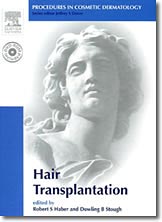April 28th, 2005
Q: I have been taking Propecia for three months. Would it help to up my dose? — F.J., Red Hook, Brooklyn, NYC
A: For most people (of average body weight of approximately 150 pounds) 1 mg is the ideal dose.
This is a statistical statement, however. There are some people who fall outside the bell curve. As we don’t know who these people are, we occasionally increase the dose on non-responders after 1-2 years, particularly for those who weigh significantly more than 150 pounds.
Remember, an increased dose also results in an increased risk of side effects and most people experience no additional benefit. There have been no scientific studies to support this regimen.
April 21st, 2005
Q: If my hair is just starting to thin, when should l have my first hair transplant? — T.O., Bayonne, NJ
A: It is best to wait until at least 25 before considering hair restoration surgery, although there are exceptions. The most important thing is to wait until you have hair loss that is a cosmetic problem. A hair transplant is a treatment for hair loss – it should not be used as a prevention. When hair loss is just starting, medical therapy is generally a better choice than surgery as it can both regrow hair and prevent future loss.
April 17th, 2005
SUMMARY of Dr. Haber’s Abstract from his presentation at the International Society of Hair Restoration Surgery, 2005 – Sidney, Australia
Harvesting high quality donor strips with minimal transaction remains an elusive goal for many hair transplant surgeons, particularly beginners. Hair restoration techniques that involve the use of scalpel blades demand the greatest skill and may cause significant transection. The Sandoval Score and Spread technique showed that non-traumatic dissection during hair transplantation is possible using a blunt instrument, but this technique is limited by poor ergonomics and the potential to cause tissue damage.
A new instrument for blunt dissection had been developed that is easy to use and is able to separate tissue along the natural planes of cleavage that causes minimal damage to hair follicles. This device has four sharp, staggered prongs aligned centrally and long handles developed for hair transplant procedures. This design utilizes the strong forearm muscles, as opposed to the weaker hand muscles, and distributes the spreading force over a larger area, minimizing trauma. A minimum depth scoring incision is made with a double-bladed scalpel to a depth of 1.5 mm. The device is inserted and expanded at intervals along the incision.
April 1st, 2005
 “Hair Transplantation” is a part of a series of medical textbooks — Procedures in Cosmetic Dermatology, published by Elsevier Saunders — which offers step-by-step, practical guides to performing cutaneous surgical procedures.
“Hair Transplantation” is a part of a series of medical textbooks — Procedures in Cosmetic Dermatology, published by Elsevier Saunders — which offers step-by-step, practical guides to performing cutaneous surgical procedures.
In “Hair Transplantation,” Dr. Bernstein co-authored the chapters on Follicular Unit Transplantation and Follicular Unit Extraction, covering the philosophy, basic science, and techniques in a practical clinical format.
The book’s editors selected Robert M. Bernstein as a major contributor, as Dr. Bernstein was uniquely qualified to provide medical professionals with insight and training on the state-of-the-art in hair transplant surgery.
March 14th, 2005
 Robert M. Bernstein M.D. was asked to provide expert medical commentary in two hair transplant videos produced by Healthology.
Robert M. Bernstein M.D. was asked to provide expert medical commentary in two hair transplant videos produced by Healthology.
The topics included “Hair Transplantation Techniques” and “Using Cloning Techniques in Hair Transplantation.”
March 10th, 2005
Synopsis: This paper reviews the core concepts of Follicular Unit Transplantation, including basing the surgical planning on the follicular unit constant, using only individual, naturally occurring units in the transplant and accomplishing the restoration in a few number of large sessions. The section then describes the techniques of follicular unit hair transplantation as the procedure enters its second decade.
March 10th, 2005
PUBLISHERS NOTE: Single copies of this article can be downloaded and printed only for the reader’s personal research and study.
Synopsis: “Surgery of the Skin: Procedural Dermatology,” covers the entire range of dermatologic surgical procedures. It was conceived to be used as the core surgical textbook for dermatologic training programs. Dr. Bernstein’s chapter on follicular unit hair transplantation covers a wide range of subjects including the history of follicular unit hair transplantation, evaluating the patient, planning the surgery, setting-up the operating room, and maximizing the cosmetic outcome of the hair restoration. Specific topics include the techniques of Follicular Unit Transplantation including density assessment, single-strip harvesting, follicular unit extraction, anesthetic use, aesthetic design and many other important topics.
March 9th, 2005
Q: If someone doesn’t have enough donor hair, do you ever perform a hair transplant using FUE, using donor hair from outside the permanent hair zone? — M.V., Nashville, TN
A: No. If hair was taken from outside the permanent zone as the surrounding hair continued to bald, the scars from FUE, although small, would become visible.
In addition, the transplanted hair would not be permanent, and over time would eventually fall out.
March 8th, 2005
Q: Does dense packing hurt grafts? — P.L., Rye, NY
A: There is no absolute answer to this question. In a hair transplant, dense packing has a risk of decreasing yield if there is a significant amount of photo damage to the scalp (which alters the blood supply) and if there is a tendency for the grafts to pop (this is difficult to predict pre-operatively). Very closely spaced grafts exacerbates the popping and exposes the grafts to desiccation (drying), hypoxia (lack of oxygen) and mechanical trauma from the necessary re-insertion.
That said, the skill of the hair transplant surgeon and placing team, the size of the recipient sites, and the way the grafts are dissected and trimmed all play important roles in determining graft survival in dense packing.
February 17th, 2005
This study also demonstrated that the Hedgehog agonist is active in human scalp in vitro as measured by Hedgehog pathway gene expression. The results suggest that topical application of a Hedgehog agonist could be effective in treating hair loss conditions, including male and female pattern genetic hair loss.


 “Hair Transplantation” is a part of a series of medical textbooks — Procedures in Cosmetic Dermatology, published by Elsevier Saunders — which offers step-by-step, practical guides to performing cutaneous surgical procedures.
“Hair Transplantation” is a part of a series of medical textbooks — Procedures in Cosmetic Dermatology, published by Elsevier Saunders — which offers step-by-step, practical guides to performing cutaneous surgical procedures.  Robert M. Bernstein M.D. was asked to provide expert medical commentary in two hair transplant videos produced by Healthology.
Robert M. Bernstein M.D. was asked to provide expert medical commentary in two hair transplant videos produced by Healthology. 


